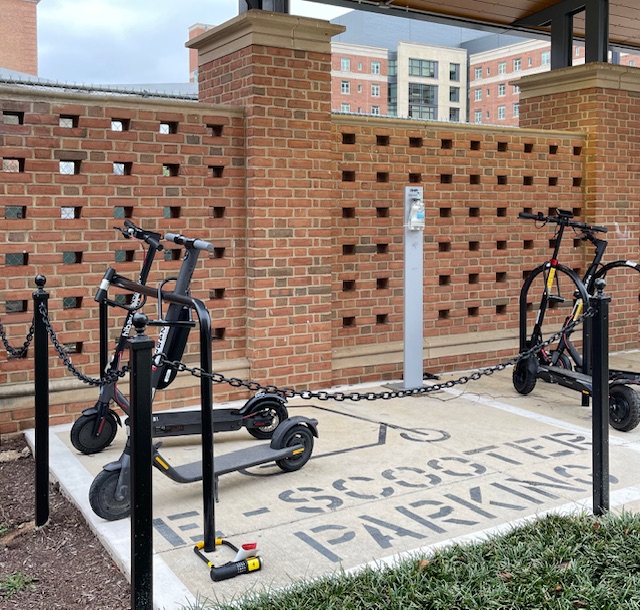
Have you found it challenging to deal with the risks of electric scooters, bikes, and other powered micromobility devices? Many facilities management and fire safety professionals at colleges and universities know the feeling. Help may be on the way in the form of the 2024 editions of the International Fire Code and National Fire Protection Association (NFPA) 1 Fire Code.
If dodging micromobility devices on the sidewalks and roads isn’t challenging enough, the lithium-ion batteries that power them have the potential to cause dangerous fires when stored and charged in buildings. The phenomenon of thermal runaway generates reactions and high heat unlike the fires we typically plan for in our buildings, especially residential and business occupancies. Current strategies for managing the risks range from considering the need and design of new storage spaces to developing and enforcing rules and regulations. The solutions have been somewhat difficult to develop because the codes have not caught up to address the hazards. Until recently, there has not been much in the form of regulatory guidance. After all, the popularity of these devices took off quickly.
Extensive research, such as that being conducted by Underwriters Laboratories (UL) and the UL Fire Safety Research Institute, is contributing to the understanding of the hazards of lithium-ion batteries and how to mitigate them. Current UL standards are included in new sections on micromobility devices in the International Fire Code and NFPA 1 Fire Code: UL 2272, the Standard for Electrical Systems for Personal E-Mobility, which is for all powered e-mobility devices, and UL 2849, the Standard for Electrical Systems for e-bikes, which is specifically for e-bikes. Both standards employ a system-level approach to evaluating safety. Both are also referenced in New York City Initiative 663-A, a local law at the forefront of micromobility device and lithium-ion battery regulation that was enacted in 2023.
The International Fire Code section 322 addresses how lithium-ion and lithium-metal battery-powered micromobility devices shall be operated and maintained. It addresses:
- prohibited locations, including use of residential occupancies for commercial charging;
- battery chargers and equipment, including the use of manufacturer-supplied equipment;
- the aforementioned UL listings; and
- battery charging areas including prohibiting extension cords and obstruction of egress.
Section 322 excepts: storage, repair, and charging in residential occupancies provided that the devices are for personal use by their owner; and charging of a single device in any occupancy by its owner. The definition of powered micromobility devices in chapter 2 excludes motor vehicles that require governmental registration.
NFPA 1 Fire Code section 10.21 applies to conditions where more than five powered micromobility devices are charged inside or within 10 feet of any building or structure regardless of whether the devices are for the owner’s personal use. It addresses charging equipment in accordance with manufacturer instructions, the aforementioned UL listings, and battery charging, including prohibiting extension cords and charging in any exit access or exit enclosure. The annex material for the definition of Powered Micromobility Device, Section A3.3.194, notes that micromobility devices are not intended to include motor vehicles registered to a government agency or motorized wheelchairs, medical scooters, shopping carts, and other similar vehicles.
It remains to be seen how these codes will be applied to—and impact—colleges, and universities. Campuses present a somewhat unique situation in that such a large percentage of the student population uses some form of powered micromobility device. It’s not inconceivable that a large residence hall could have hundreds of residents wanting to store and charge their devices.
During an interactive session on lithium-ion batteries and micromobility devices at the 2023 the Center for Campus Fire Safety (CCFS) Campus Fire Forum, the majority of attendees said that their primary form of managing micromobility risks is prohibiting all such devices in campus buildings. This is especially true in residential facilities. Other strategies discussed included a registration process for micromobility devices requiring proof that they are certified to meet the UL standards. Some campuses are exploring the creation of dedicated charging rooms or areas either within buildings or outside, solutions that may have to apply NFPA 855 Standard for the Installation of Stationary Energy Storage Systems, whose scope includes the storage of lithium-metal and lithium-ion batteries.
As for evaluating whether there is a powered micromobility device fire problem on campuses, the Center for Campus Fire Safety (CCFS) has created a voluntary reporting system. From it, information will eventually be compiled in a database that may assist with risk-based solutions. Campus officials are encouraged to report any campus fires related to micromobility devices or other lithium-ion battery devices by going to myccfs.org and clicking on Micromobility/Lithium-Ion Battery Fire Reporting Program.
Codes are quickly catching up to what seems to be the overnight growth of micromobility devices, but there is still much research to be done on lithium-ion battery safety. For now, the new codes, along with established standards and extensive research-based information available from organizations like Underwriters Laboratories, can help campuses address the risks of lithium-ion powered micromobility devices.
Alan Sactor is the University of Maryland Fire Marshal and assistant director of the university’s Department of Environmental Safety, Sustainability, and Risk. Alan is also vice president at the Center for Campus Fire Safety and a member of the APPA Standards and Codes Council. He can be reached at [email protected].
Code Talkers
Code Talkers: Highlights the various codes, laws, and standards specific to educational facilities and explains the compliance issues and implications of enforcing these measures. To contribute, contact Kevin Willmann, FM Column Editor.
See all Code Talkers.


